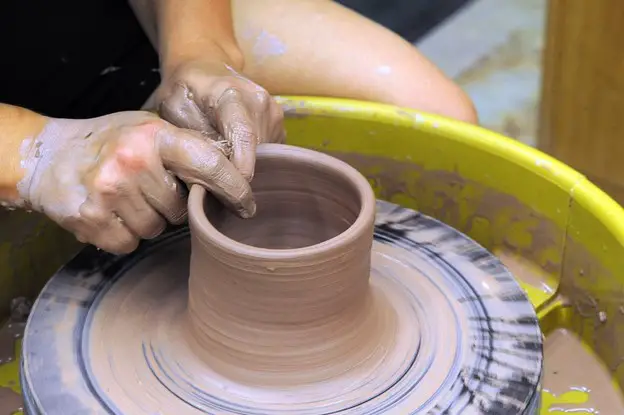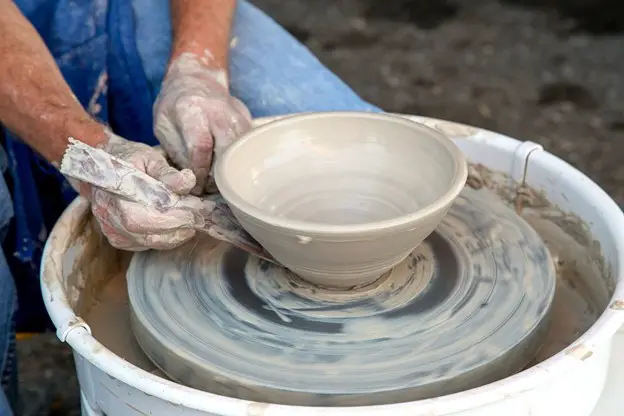A potter’s wheel helps shape & round the pottery wares with the help of a technique termed throwing. The wheel’s speed helps determine how well the clay would center and form a shape. Understanding the cues for obtaining the right wheel speed will help make the process of pottery making easier for artists.
So, how fast must the potter’s wheel spin?
However, the answer to this would vary depending on the stage of pottery you are at. Having access to an electric pottery wheel with speed control options could be a great asset to the pottery-making process. You can alter the wheel’s speed from basically zero all the way to 240 RPM or even 300 RPM depending on the wheel’s brand.
Finding the Speed Balance of the Pottery Wheel
When preparing your masterpiece on a pottery wheel, you need to attain the right balance between lower and higher speeds. A wheel that is too fast can cause trouble in shaping up the clay piece. On the other hand, you might also face problems with the clay if the pottery wheel is moving too slow.

As a potter, you need to exercise caution in terms of speed for pots with thinner walls. It could lead to the pottery piece becoming wobbly, wonky, or even collapsing completely. The speed of the pottery wheel would also vary depending on the ceramic ware you plan on creating.
During the wheel spinning process, the pottery wheel should range between 100 and 150 RPM. This counts for half or 1/3rd of the original wheel speed. On the other hand, if you plan on smoothing out your pottery piece with the help of a rib or sponge, you should slow down and maintain a speed of around 30 to 40 RPM. If you are looking for an ideal pottery rib for shaping purposes, the Mudtools Rib for Ceramic Pottery could be an ideal choice. This soft, kidney-shaped pottery tool is perfect for finishing and shaping the clay.
Must-Know Pottery Wheel Speed Practices
When you switch the wheel’s speed, it is advised that you slowly take off your hands from the pottery piece. The sudden speed change and letting go of your touch from the pottery piece can move the ceramic piece off-center. When working with clay pieces, you must keep your finger pressure even and steady throughout to help avoid the possibility of thin spots. Make sure there is an evenly distributed gaping system between the fingers to pull up your clay piece properly.
Most beginner potters tend to increase the speed rotation in one go that can hurt your ceramic piece’s overall integrity.
Speed Varies Depending on a Potter’s Personal Preference
There is no mathematical formula to determine the exact necessities in terms of pottery speed. It is more of a personal preference. While some potters take it slow for the formation of clay shaping, others are comfortable with higher speeds for the shaping purpose.
However, it is a known fact that higher speeds can cause the clay to collapse. Given that the potter’s wheel moves with the help of a centrifugal force, the clay will automatically move in the outward direction. This would form a bowl-like shape and eventually get wobbly and collapse all of a sudden. So, always start slow. As you advance in your skillset, you can surely increase the speed and achieve better control.
Switching Between Speeds for Different Stages of Pottery
During Centering:
When you are centering your clay on a pottery wheel, the key is to go faster. This will help you use the wheel’s centripetal force and aid in the crafting process. In simple words, going faster is ideal for the clay centering process. It is recommended that you use high or medium-high wheel speed. In case the wheel moves too slowly, the clay piece would move more than your hand, which would make the clay difficult in terms of centering.
During Throwing:
When you plan on throwing & forming the piece, the key is to go for a slower or medium speed. You cannot do much with the clay if your wheel is revolving at a 300 RPM speed. Once you are done centering, slowly bring down the speed of the wheel to a range of 80 to 150 RPMs. Most expert crafters tend to move the wheel at a medium or medium-low speed. With some testing and trails, you can find which speed works best when throwing or forming your pottery piece. Try not to take up the speed too fast or too slow.
During Trimming:
This is an intricate process, and you wouldn’t want to go too slow or too fast during this stage or pottery. With speed too fast, you might see the pots flying away from the wheel. On the other hand, if you move slower, your wheel might come to a halt. Medium speed is the sweet spot for trimming purposes. Only with some practice, you can determine the perfect speed for peeling off your clay piece.
Apart from this, the weight of your clay can also be an important factor in determining what speed works best for you. For clay that is 2 pounds or less, the maximum ideal speed would be 50 or 40 percent of the machine’s standard speed. Alternatively, clay pieces that are 3 pounds or more require the potters to go about 40 to 30 percent of the original speed.
Simply put, when crafting larger pieces, go with a slow speed as you need more control for a larger body. On the other hand, smaller pieces do well with faster speed as you have a smaller piece to control.
Pottery Stage |
Ideal Speed |
| Smoothing (With Rib or Sponge) | 30-40 RPM |
| Centering | 100-150 RPM |
| Throwing | 80-150 RPM |
| Trimming | 30-40 RPM |
Conclusion
Electric wheels feature foot pedals for speed control that add to the ease of use. If you aren’t comfortable with foot pedals, you can also opt for hand control variants. When getting a pottery wheel for yourself, make sure you check the wheel speed and torque in the packaging to determine whether it fits your need. Pottery wheels with bigger and faster motors are ideal for crafting big pots. It is great if you are an expert crafter. However, for beginners, an average-sized pottery wheel is good for practice!







